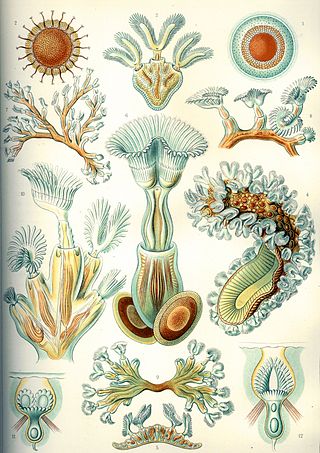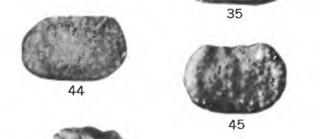
Bryozoa are a phylum of simple, aquatic invertebrate animals, nearly all living in sedentary colonies. Typically about 0.5 millimetres long, they have a special feeding structure called a lophophore, a "crown" of tentacles used for filter feeding. Most marine bryozoans live in tropical waters, but a few are found in oceanic trenches and polar waters. The bryozoans are classified as the marine bryozoans (Stenolaemata), freshwater bryozoans (Phylactolaemata), and mostly-marine bryozoans (Gymnolaemata), a few members of which prefer brackish water. 5,869 living species are known. At least two genera are solitary ; the rest are colonial.

The International Bryozoology Association (IBA) is a professional association with international membership specialising in research of the phylum Bryozoa.
The Sonoma orogeny was a period of mountain building in western North America. The exact age and structure of the Sonoma orogeny is controversial. The orogeny is generally thought to have occurred during the Permian / Triassic transition, around 250 million years ago, following the Late Devonian Antler orogeny. The Sonoma orogeny was one of a sequence of accretionary events along the Cordilleran margin, possibly caused by the closure of the basin between the island arc of Sonomia and the North American continent. Evidence of this event has been reported throughout western North America, but most distinctly in northwest Nevada.
For the former New Zealand politician, see Helen Duncan (politician). For the Scottish Medium, see Helen Duncan.

Cystoporata, also known as Cystoporida or cystoporates, are an extinct order of Paleozoic bryozoans in the class Stenolaemata. Their fossils are found from Ordovician to Triassic strata.

Paleontology or palaeontology is the study of prehistoric life forms on Earth through the examination of plant and animal fossils. This includes the study of body fossils, tracks (ichnites), burrows, cast-off parts, fossilised feces (coprolites), palynomorphs and chemical residues. Because humans have encountered fossils for millennia, paleontology has a long history both before and after becoming formalized as a science. This article records significant discoveries and events related to paleontology that occurred or were published in the year 2014.
The Gnishik Formation is a geologic formation in Armenia, Azerbaijan and Iran. It preserves fossils dated to the Wordian age of the Permian period.
Clausotrypa is an extinct genus of prehistoric bryozoans in the family Nikiforovellidae. The species C. elegans is from a Wordian (Permian) marine horizon in the Sijiashan Formation of Northeast China.
Paleontology or palaeontology is the study of prehistoric life forms on Earth through the examination of plant and animal fossils. This includes the study of body fossils, tracks (ichnites), burrows, cast-off parts, fossilised feces (coprolites), palynomorphs and chemical residues. Because humans have encountered fossils for millennia, paleontology has a long history both before and after becoming formalized as a science. This article records significant discoveries and events related to paleontology that occurred or were published in the year 2015.
Crurithyris is an extinct genus of brachiopod belonging to the order Spiriferida and family Ambocoeliidae.
Phestia is an extinct genus of clam belonging to order Nuculanida and family Nuculanidae.
Schizophoria is an extinct genus of brachiopod belonging to the superfamily Enteletoidea. Specimens have been found in Devonian through Permian beds in North America, Australia, central and southeast Asia, and eastern Europe.
Septopora is an extinct genus of bryozoan belonging to the order Fenestrida. It has been found in Pennsylvanian to Permian beds in North America, South America, Australia, and southwest and east Asia.
Leiorhynchus is an extinct genus of brachiopod belonging to the order Rhynchonellida and family Leiorhynchidae. Specimens have been found in South America, North America, and Russia in beds of middle Devonian to Mississippian age. The genus may have been adapted to dysaerobic environments, colonizing areas of reduced oxygen concentrations rich in organic matter. The genus has been used as an index fossil in North America.

Marginifera is an extinct genus of brachiopod belonging to the order Productida. Specimens have been found in Carboniferous to Triassic beds in Asia, Europe, Madagascar, and North America.

Amphissites is an extinct genus of ostracod belonging to the suborder Beyrichicopina and family Amphissitinae. Species belonging to the genus lived from the Devonian to the Permian in Europe, North America, Australia, and east Asia. The genus were likely deposit-feeders, and may have survived briefly into the Triassic.

Roundyella is an extinct genus of ostracod belonging to the order Leperditellocopida and family Scrobiculidae. Specimens have been found in beds of Devonian to Triassic age in Australia, Asia, Europe, North America, and South America.
Laxifenestella is an extinct genus of bryozoans of the family Fenestellidae, found from the Devonian period to the Permian 412.3 to 254.0 million years ago. The genus colonies consist of a mesh of mostly straight branches in a fan-like or funnel-like shape. There are several species belonging to the Laxifenestella genus being L. borealis, L. texana, L. contracta, L. exserta, L. firma, L. morozova, L. lahuseni, L. oviferorsa, L. sarytshevae, L. stuchugorensis and L. stuckenbergi. Parent taxon of this genus is Fenestellidae with siste taxons being Alternifenestella, Minilya, Spinofenestella. Fossils of the laxifenestella genus in the permian period are found in Australia, Canada, Iran, Omen, Pakistan, and Russia. Fossils from the Carboniferous period are found in spain with Devonian period fossils being found in the Czech Republic. In total there are 22 fossils belonging to the Laxifenestella genus.
Neoeridotrypella is an extinct genus of bryozoan of the family Eridotrypellidae, known from the Permian period. Its colonies were typically branching or tree-shaped though sometimes encrusting or massive, and the walls of its zooecial chambers were thicker within the exozone and full of tiny tubules.
Stenodiscus is an extinct genus of bryozoan of the family Stenoporidae, known from the Carboniferous to the Upper Permian periods. Its colonies were large and could be encrusting, massive, or branching, sometimes made of multiple layers of growth over themselves, and usually possessed monticules with abundant large acanthostyles.






